March 17, 2006
Air Date: March 17, 2006
FULL SHOW
SEGMENTS
New Interior Head Picked
View the page for this story
President Bush has nominated Idaho governor and former U.S. Senator Dirk Kempthorne to be the next Secretary of the Interior, replacing Gale Norton. Host Steve Curwood talks with Living on Earth’s Washington correspondent Jeff Young about Kempthorne’s record on the environment. (05:30)
Moons & Money
View the page for this story
Astrophysicist Neil deGrasse Tyson tells host Steve Curwood why water spewing geysers may mean there’s life on one of Saturn’s moons, and how proposed budget cuts could affect the search for life and other space science programs. (06:15)
Biosphere 2 PLUS 15
/ Rene GutelView the page for this story
A look back at the people who locked themselves inside a giant terrarium in Oracle, Arizona 15 years ago as part of an experiment in environmental science. Rene Gutel of member station KJZZ has an audio collage of the history, ecology and human frailty that was Biosphere Two. (07:00)
Emerging Science Note/Inoculating Mosquitos
/ Emily TaylorView the page for this story
Researchers at the University of California have successfully created a genetically altered line of mosquitoes that are resistant to the most common type of dengue fever. There are an estimated 50 million people infected with the dengue virus each year. Emily Taylor reports. (01:30)
Field Notes
View the page for this story
New Yorker staff writer, Elizabeth Kolbert, has been called the "Rachel Carson of global warming." She's been reporting on the issue since her series first ran in the New Yorker last year. Now she's turned the knowledge she's gained in the field into a new book: “Field Notes From a Catastrophe: Man, Nature, and Climate Change." She speaks with Living on Earth's Bruce Gellerman. (08:30)
Early Signs: Reports From a Warming Planet
/ Nick Miroff and Jon MooalemView the page for this story
Living on Earth kicks off a six-part series of reports from places where climate change concerns are already bringing change. First stop: Churchill, Manitoba where Nick Miroff and Jon Mooalem report diminished polar ice is forcing a town to reexamine whether it has any future as "The Polar Bear Capital of the World." (15:00)
This week's EarthEar selection
listen /
download
The red, red robin comes a-bobbin’.
Show Credits and Funders
Show Transcript
HOST: Steve Curwood
GUESTS: Neil deGrasse Tyson, Elizabeth Kolbert
REPORTERS: Jeff Young, Nick Miroff
PRODUCERS: Rene Gutel, Jon Mooallem
NOTE: Emily Taylor
[THEME MUSIC]
CURWOOD: From NPR - this is Living on Earth.
[THEME MUSIC UP AND UNDER]
CURWOOD: I’m Steve Curwood. President Bush has nominated Idaho Governor Dirk Kempthorne to become Secretary of the Interior. At a White House ceremony, the governor told the president:
KEMPTHORNE: I consider it a great honor and accept your charge to be a responsible steward of the land and the natural resources with which our nation has been blessed:09
CURWOOD: The interior secretary sets much of the policy for oil and gas drilling on public lands.
Also, remembering the great experiment to live in a totally artificial world.
POYNTER: Before we went into biosphere 2 the project was the poster child if you will for space exploration, for environmental and ecological research. It really did talk about hope for the humanity and vision for the future. But I think it was over-hyped.
CURWOOD: Those stories and more - this week on Living on Earth. Stick around.
[NPR NEWSCAST]
ANNOUNCER: Support for Living on Earth comes from the National Science Foundation and Stonyfield Farm.
[THEME MUSIC]
New Interior Head Picked
CURWOOD: From the Jennifer and Ted Stanley Studios in Somerville, Massachusetts, this is Living on Earth. I’m Steve Curwood.
President Bush has nominated Idaho Governor and former Senator Dirk Kempthorne as the next Secretary of the Interior. If confirmed by the Senate, Governor Kempthorne would replace Gale Norton, the first woman to become secretary of the interior. Ms. Norton resigned after five years of aggressively expanding energy development on federal lands. Critics say that came at the expense of conservation.
The interior secretary is responsible for some 500 million acres of land, vast offshore resources, national parks, protection of endangered species, and relations with Native Americans. The interior also leases and permits mining and drilling for roughly a third of the country’s domestic energy production. In short, it is an important position.
Here to talk about what sort of interior secretary Governor Kempthorne might make is our Washington correspondent, Jeff Young.
YOUNG: Hi, Steve.
CURWOOD: Jeff, what do we know about Dirk Kempthorne’s environmental record?
YOUNG: As a senator he tried unsuccessfully to overhaul the Endangered Species Act, something most environmental groups strongly opposed. And he rarely voted with conservation groups’ wishes.
Tiernan Sittenfeld is with the League of Conservation Voters. They rank members of Congress in a sort of scorecard, and she says Kempthorne scored very poorly.
SITTENFELD: In fact, voting with the environment just one percent of the time. And that’s why it’s particularly alarming to think that he could be in a position of overseeing public lands and wildlife all across the country.
CURWOOD: Now Jeff, Dirk Kempthorne left the Senate a decade ago to run for governor of Idaho. What’s he done on the environment as governor?
YOUNG: He’s pushed hard for more money for states’ parks. He generally resists big ambitious federal programs on the environment. For example, he did not like Clinton’s proposal to protect roadless areas in national forests. And late in the Clinton years, Governor Kempthorne sued to stop a plan that would have returned grizzly bears to Idaho. After Bush won the 2000 election, Secretary Norton withdrew that plan, by the way. And Kempthorne also fought the Environmental Protection Agency over a Superfund cleanup site in Idaho he thought grew too large and too costly. Here’s how he put it at the time.
KEMPTHORNE: I told the EPA that I am so frustrated with them that I'm on the verge of inviting them to leave the state of Idaho.
YOUNG: So he’s more inclined toward state and regional approaches to problems—on water rights, for example, he recently settled a dispute with a tribal government on who gets access to the Snake River. And he’s part of a four-state effort on salmon recovery. Now, that has upset some Idaho conservation groups I spoke with. They say Kempthorne has blocked attempts to remove some dams, which is what they say must happen to bring back endangered salmon. But in a conference call with reporters just after his nomination was announced, Kempthorne defended his environmental record.
KEMPTHORNE: I have a record that I’m proud of. But if you look at, for example, efforts such as reform of the Endangered Species Act--bipartisan support. So, I really believe that as people look at this and as they want someone who is willing to sit down with them at the table and take on some tough issues that do exist out there, but that they’re going to have an opportunity to have their say, I think ultimately will be successful.
CURWOOD: Now Jeff, we tend to think of the interior as running the national parks but energy development has really defined the Interior Department under Secretary Norton—she pushed for more drilling permits out west, more offshore drilling and, of course, she led the fight to open the Arctic National Wildlife Refuge to oil exploration. Where do you see Kempthorne on energy issues?
YOUNG: Well, I expect he will continue the policies Norton put in place to speed up drilling permits on public land. This has become very divisive especially out along the Rocky Mountain Front where a lot of communities see drilling pads and roads eating up the landscape. But it’s also pumping a lot of money into local economies and state coffers. I spoke with Brian Hinchey. He’s with Wyoming’s Petroleum Association. He’s pleased with this choice for Secretary of the Interior. He wants Kempthorne to stay on the course that Norton set.
HINCHEY: You know, those are hard shoes to fill. I think Gale did an excellent job not only for our industry but for other industries in our state and in western states. And she’s tried to be as balanced as she can and it’s a tough row to plow, but she’s done a good job of that.
YOUNG: And offshore drilling is of course another hot issue, and we’ll find out very soon what Kempthorne thinks on that because Florida’s Democratic Senator Bill Nelson says he’s going to place a hold on this nomination until he gets a promise that drilling in the Gulf of Mexico won’t get too close to Florida’s coastline.
CURWOOD: And finally, Jeff, what are the chances for Governor Kempthorne to get confirmed as secretary of the interior?
YOUNG: Very good I’d say. Response from the Senate has been very positive. And of course, he’s one of theirs. He’s a former senator and former senators have a very good record being confirmed by the Senate.
CURWOOD: Jeff Young is Living on Earth’s Washington correspondent. Thanks, Jeff.
YOUNG: You’re welcome.
[MUSIC: Grassy Knoll “Spirit Slips” from ‘III’ (Nettwerk - 1998)]
Moons & Money
CURWOOD: Scientists have found yet another place where there may be life beyond Earth. New data shows that one of Saturn’s moons has water--one of the essential elements of life--spewing from its surface.
And with me now is Neil deGrasse Tyson. Dr. Tyson heads New York's Hayden Planetarium, and is a regular contributor to our program. Welcome back to Living on Earth, Neil.
TYSON: Pleasure to be back, thanks.
CURWOOD: And it’s good to have you here. Hey, let’s talk about these new findings on one of Saturn’s moons. This moon is called Enceladus, and the information came from the Cassini spacecraft. What exactly did it find?
TYSON: Well, it found evidence of a plume rising up from the surface of this moon of Saturn. Saturn is far enough away so that anything out there is just frozen, and this moon is duly frozen on its surface. But then you have this plume rising up from a frozen surface, and that raised some eyebrows. And if you look at other auxiliary data you’re left with no other conclusion than that you have this pool of water under pressure beneath this frozen surface; and if you build up enough pressure, and you have the heating from Saturn, you can evaporate some of that water, and it’ll punch through and make a geyser just like what you have at Yellowstone National Park. Except these geysers are ice geysers rather than hot water geysers.
CURWOOD: What’s heating it up?
TYSON: Well, there’s several heating sources in the Saturn system. There’s a radiation field. There’s also the tidal forces of Saturn on the moon; they actually have a way of stressing the solid planet, the way when you hit a racket ball the ball starts to get warm because you stressed it and it punched back into shape. When you do that with a solid body you end up heating up the body, and what might have been frozen down beneath the surface begins to liquefy, and that action can create interesting sort of geological features and geological behavior for these moons. And Enceladus is not the only moon that demonstrates this heating and consequences from it; there are moons of Jupiter that do this, as well. So, we were well-equipped to interpret what we saw.
CURWOOD: So now, how does this all relate to the question of life beyond Earth?
TYSON: That’s an excellent question because… I heard a comedian joke, why do we spend all this money looking for water when it’s just something that comes out of your kitchen faucet? (Laughs)
CURWOOD: (Laughs)
TYSON: The difference is there are no aliens coming out of your kitchen faucet. I think. Water, on Earth, is always associated with life – liquid water, that is. Wherever you find water, you find life. Wherever you find life, you find liquid water. And so that shapes the way we pose our questions as we explore the solar system. We want to look for the water, and by doing so, we believe, significantly increases our chances of finding life. Or, more specifically, life as we know it. So water is always a tantalizing find whereever we discover it.
CURWOOD: By the way, where else in the solar system might there be life?
TYSON: Well, let me first tell you the places where there’s water. We still don’t know if there’d be life there; we need some more experiments. Certainly, Enceladus. We’ve got liquid water in Jupiter’s moon Europa. That one is also heated by the tidal forces of Jupiter, and we’ve been eyeing that one for quite some time, actually. In fact, there’s even a mission in planning, but not funded, to got to Europa and try to perform experiments that would search for life that may exist beneath the frozen surface.
Also top of the list, of course, is Mars. As a planet, Mars has all this evidence of once having had liquid water flowing on its surface. It may have even been an oasis. All of that’s gone now. Something bad happened on Mars, something we don’t know, and so the study of Mars can be extremely important if we want to keep the flowing of water here on Earth. So, this search for life can ultimately point right back to us for our own survival.
CURWOOD: Speaking of Mars, I was looking at that new site on Google, Google Mars, where you can just look at all the craters and dunes and everything. That’s so exciting.
TYSON: I’ve seen the Google Earth site. I have yet to check out the Google Mars site, but I’m completely jazzed by the idea. Because the Google Earth allows you to become even more familiar with Earth, not as just some place that has warring factions, but as an orb, as a planet. You can think of where you live on a planet rather than in a nation, for example.
And by doing the same for Mars it’s a good thing because it brings Mars into your office, or into your home, in the way Earth is brought into your home. And that’s how it ought to be, because the solar system is not someplace out there, it is our backyard. It is a space we share with other planets. And so the more of that, the more familiar we become with our cosmic environment, I think the more understanding we can bring to even our own planet.
CURWOOD: Neil, let’s turn to the NASA budget for a moment. As I understand it, while the overall budget goes up a little bit some things are being deeply cut. For example, the folks that study life, or the prospect of life, on other parts of the solar system – astrobiology is being cut. And some of the satellites that monitor the weather on the Earth, and climate systems, those are being cut. What’s going on here?
TYSON: Yeah, the cuts are not unique to Earth-monitoring or to astrobiology – they’re spread across many sub-disciplines within the sciences of NASA. And what has happened is there’s been a redistribution of monies within the agency to enable the shuttle to finish its directive to complete the construction of the space station. We have obligations to international partners to run that through its course. My hope is that by the time that’s done there can be a renewed era for NASA where we can redouble what has been a very successful science portfolio in the NASA activities over the past decades.
CURWOOD: Neil deGrasse Tyson is an astrophysicist and head of the Hayden Planetarium in New York. He’s also the new host of the PBS science magazine “NOVA ScienceNow” beginning this fall season. Neil, thanks for taking the time.
TYSON: Thanks for having me on.
Related links:
- Cassini Discovers Water on Saturn’s Moon Enceladus
- Cassini Imaging Team Site
- Google Mars (new interactive site)
[MUSIC: Frank Comstock “When You Wish Upon A Star” from ‘Project Comstock: Music From Outer Space’ (1960)]
CURWOOD: Coming up: the bubble that burst. Biosphere 2 turns 25. Stay tuned to Living on Earth.
[MUSIC: Doctor Rockit “Male James Bonding” from ‘The Only Blip Hop Record You’ll Ever Need, Volume 1’ (Luaka Bop – 2002)]
Biosphere 2 PLUS 15
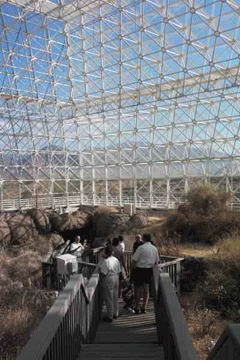
Public tours inside the biosphere. (Photo: Rene Gutel)
CURWOOD: It’s Living on Earth. I’m Steve Curwood. Fifteen years ago, four men and four women walked inside a huge glass and steel terrarium in Oracle, Arizona, and locked themselves in for the next two years. The project and the structure were called Biosphere 2, and “the Biospherians,” as they called themselves, lived in the closed, supposedly self-sufficient environment, with an eye towards the future colonization of space. It was not easy. They struggled to maintain healthy oxygen levels, and struggled among themselves. From member station KJZZ in Phoenix, Renee Gutel has this look back at Biosphere 2, the people who were part of it, and some of the lessons they learned.
POYNTER: My name is Jane Poynter, and I’m one of eight people that lived inside Biosphere 2 for two years and 20 minutes. Before we went into Biosphere 2 the project was the poster child, if you will, for space exploration, for environmental and ecological research. It really did talk about hope for humanity and vision for the future. But I think it was overhyped.
[MUSIC]
PETER JENNINGS: Tonight we put a fascinating look into our future on the American agenda. A look into the future through the eyes and thoughts of eight men and women who are about to enter a tiny, manmade world in the middle of the Arizona desert.
LOCAL NEWSCASTER: Well, today we’re another step closer to creating the space station of the future.
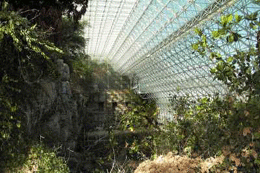
A view of the rainforest and ocean biome from within the biosphere. (Photo: Rene Gutel)
POYNTER: You have to remember that when we started this project in the mid-80s, almost everyone was saying, you know, is this possible? The whole thing’s going to turn into green slime! You’re all going to get some terrible lung infection and die! People really did have some serious questions about whether sealing people up inside an enclosed environment with all these plants and animals was suicide.
[MUSIC]
LEIGH: I’m Linda Leigh. I’m a systems ecologist, and for eight years I was involved in the Biosphere 2 project. From 1991 through 1993 I was a Biospherian, and I lived inside with seven other people without coming out for two years.
POYNTER: We went into the facility on September the 26th, 1991.
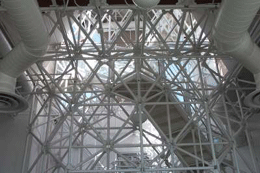
Inside the biosphere. (Photo: Rene Gutel)
GOVERNMENT SPOKESMAN: Office of the Governor Proclamation, Arizona Biosphere 2 closure celebration date.
[APPLAUSE]
LEIGH: We walked in, the door closed, and finally, when we walked up into our living quarters, we weren’t being filmed anymore and we all just gave a big sigh of relief that we made it. It’s kind of like, finally!
[MUSIC]
LEIGH: When we closed the door in the Biosphere the oxygen level was a little bit lower than the ambient – and the ambient being what we breathe right here outside – and the carbon dioxide was a little bit higher than the ambient. And after a period of months the carbon dioxide kept increasing inside and the oxygen was decreasing. So we not only had an atmosphere that was not very healthy for humans, because of the low oxygen and high CO2, but we had a puzzle. We had a mystery.
POYNTER: At the time, everyone cringed and went, “Oh my goodness! You know, everybody’s going to think, you know, we’re complete frauds now because we’ve got this oxygen problem!”
LEIGH: And we said, “well, we can either all go out and take the vertebrate animals with us, or we can stay in and write it down and die, or we can add oxygen from the outside and see what we can do to try to lower the CO2. “
POYNTER: You feel incredibly lethargic. It gives you mood swings, it can cause depression, it’s difficult to do anything. You couldn’t complete a sentence without taking a breath. It was really quite dreadful.
[MUSIC]
LEIGH: What it felt like was eight crabby people trying to live together and work really hard together. And when the oxygen was added, I’ve got to say, a big weight seemed to be lifted.
POYNTER: We ended up having to add oxygen because it was a medical issue. I mean, you just can’t survive on the amount that was in the atmosphere when we pumped it in. It was at 14.2 percent when we pumped in oxygen. And yeah, we let it go down as far as we could.
[MUSIC]
POYNTER: The crew of eight people divided into two factions of four around the sixth month mark.
LEIGH: The split was contentious. When I look back at my behavior during that time I feel pretty shocked. It was really awful. Where I would be so cold to the people in the other group, walking by them and not even looking at them. And, you know, you’re in a close system – there’re only eight people – that’s pretty awful.
LEIGH (ARCHIVAL AUDIO): I mostly miss my friends on the outside in Biosphere 1. The most important message that I personally have is the message of being able to communicate. And certainly inside of Biosphere 2, in order to make the entire system work, we need to be able to talk to each other and to discuss with each other what’s happening.
[MUSIC]
LEIGH: You know, a lot of what that was about was resources. We didn’t have enough food, we didn’t have enough water, we didn’t have enough time.
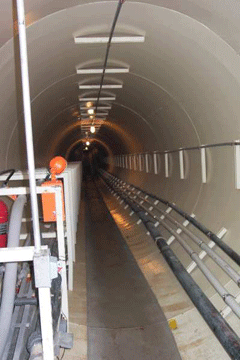
Underground in the biosphere. (Photo: Rene Gutel)
[MUSIC]
NEWSCASTER: Biosphere. Some charge it could bring an early end to the scientific project. The Tucson TV report reveals scientists learned the plants alone could not remove enough carbon dioxide from the indoor atmosphere.
PETER JENNINGS: When it opened it was touted as a prototype for human colonies in space. It’s going to be very difficult if they have the kind of trouble in space that they’re having near Tucson.
[MUSIC]
LEIGH: Unfortunately, we set ourselves up for failure by saying at the outset that we were not going to add anything for a hundred years.
POYNTER: I think a lot of people felt betrayed, to some degree, because, you know, we had said we’re not going to take anything in! It’s going to be materially closed. Well, of course, I mean that’s really a rather ridiculous statement.
LEIGH: There is our core group of people, the Biospherians and a few of the other people involved in the idea of the Biosphere, who are like a little army of people who were convinced that it was going to be absolutely perfect when we closed the door. It’s silly in retrospect, but maybe we had to think that way in order to get it done.
[MUSIC]
CURWOOD: Our look back at Biosphere 2 was produced by Renee Gutel. By the way, if you’re looking for some prime Arizona real-estate, Biosphere 2 is up for sale. One developer is already eyeing the site for luxury homes. But BYOO – bring your own oxygen. To see photos of Biosphere 2 see our website, Living on Earth dot org.
[MUSIC]
CURWOOD: Coming up: field notes from a catastrophe waiting to happen. A reporter’s observations on climate change. First, this Note on Emerging Science from Emily Taylor.
[SCIENCE NOTE THEME]
Emerging Science Note/Inoculating Mosquitos
TAYLOR: Bad bugs bugging you? Now there’s a reason to fear the little pests a little less. Researchers, headed by University of California-Irvine vector biologist, Anthony James, have successfully created a mosquito that is highly resistant to the Type 2 dengue fever virus. They did it by identifying a vulnerability in the virus. It happens when the virus replicates and leaves its RNA susceptible to being chopped up by a naturally-occurring protein, dicer-2. If dicer-2 goes to work, the damaged RNA prevents the virus from replicating.
This process happens naturally only after the virus has replicated enough times to be transmitted. But by cloning a section of the mosquito’s RNA and injecting two inverse copies of it into mosquito embryos, James and his team were able to let the dicer-2 protein do the chopping before initial replication and transmission occurred. As a result, the virus never replicated at all.
This genetically altered and, now, benign virus was used to “inoculate” and create a new line of mosquitoes highly resistant to the dengue fever and able to pass this resistance down to future generations. Dengue fever is endemic in more than 100 nations, it infects an estimated 50 million people each year and kills 20,000 of them. James says he and his team will now look into population replacement strategies to eliminate carriers of dengue fever and infection rates. That’s this week’s Note on Emerging Science, I’m Emily Taylor.
Field Notes
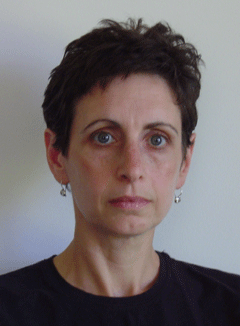
CURWOOD: It's said if you set a frog into a pot of water and gradually turn up the heat, the frog won't notice. It'll stay in the pot and eventually die. Well, our planet is our pot, and scientists say we're the ones turning up the heat, and we're also the frog, when it comes to global warming.
Almost each week, it seems, there’s another sign pointing to a changing climate. Just recently, scientists noticed a sharp jump in the increase of carbon dioxide, a key factor in warming the Earth. Other researchers note that the Arctic Ocean ice has failed to reform for the second year in a row.
New Yorker magazine staff writer Elizabeth Kolbert has been to the front lines on the global warming story. Living on Earth’s Bruce Gellerman spoke with Ms. Kolbert about the book she brought back: “Field Notes from a Catastrophe: Man, Nature, and Climate Change.”
GELLERMAN: You did a lot of traveling for this book.
KOLBERT: Yes, I did. I went, well, I won’t say around the world, but to Greenland and to Alaska and to Europe and to the West Coast, so as many places as I possibly could.
GELLERMAN: You say that the world is getting hotter than any time in the last 2,000 years, and by the end of the century it will be hotter than the last two million years. But is this unprecedented? Haven’t we had, you know, periods of intense and very speedy warming of the planet followed by long periods of very cold?
KOLBERT: Yes, but we are now, you know, in the 10,000 years into an interglacial, and we are basically near the peak of temperatures that we’ve seen in any recent interglacial. And as you keep putting carbon dioxide into the atmosphere you keep raising the temperature. That’s just the basic physics of global warming. So the predictions are that we will leave what people call the envelope, climate envelope, of natural variability quite soon; and we will be entering territory that the Earth has been through before, but it just so happens that humans were not around during that time period.

(John Kleiner ©)
KOLBERT: Yes. When you burn fossil fuels you create aerosols, which are basically the same thing that you get when you have a volcanic eruption. And as people know, when you get volcanic eruptions you do tend to get a period of cool weather – you know, the year without a summer, it’s sometimes referred to. And that is why people think that actually the effects of global warming have probably been masked. The 50s and the 60s were pretty cool decades, and people had a hard time understanding that until they factored in aerosols, the effect of aerosols.
But what you’re seeing now is aerosols are pretty short-lived, and also aerosols are something that we’ve tried to get control over because they cause things like lung cancer. So what you’re having now is as CO2 levels go up, and aerosol levels remain relatively steady, you see the effects of greenhouse gases canceling out the aerosol effects. And now we’re heading into a territory people expect to be of quite dramatic warming.
GELLERMAN: What I found interesting in your book was that this is actually a feedback system: that when you start melting ice and glaciers, there’s organic materials frozen in the ice that starts decaying, and that gives off methane and carbon dioxide, and that accelerates the whole process.
KOLBERT: Well, that is why people will say it’s so, so important to start dealing with our emissions, because once you set some of these feedbacks in motion, once you – some of these processes are irreversible because they feed on themselves, precisely what you’re saying. And one of the reasons scientists are so concerned, for example, about what we’re seeing with the shrinking of the Arctic ice cap, is that the Arctic ice cap has a huge affect on the climate. Because it reflects sunlight back into space, so that sunlight is not being absorbed, that energy is not being absorbed. And once you start to melt that back, as we’re seeing now, more and more energy is getting absorbed by the dark surface of the water. It’s the same principle at work as, you know, when you wear light clothes in the summer and dark clothes in the winter. So that dark water absorbs the heat and it melts back more ice, and that feeds on itself.
GELLERMAN: Ms. Kolbert, in all your research, have you come across any convincing science that denies the veracity of global warming?
KOLBERT: I guess, in a word, no.
GELLERMAN: Not a shred of evidence that would suggest that this is all hooey?
KOLBERT: You know, I can’t stress strongly enough that no one denies – no one – no one denies the basic principle that CO2 causes warming. In fact, there’s what we call the natural greenhouse effect, and that is why we are here. And it is greenhouse gases that are in the air naturally, and that’s the reason why the Earth is habitable. If we had no greenhouse gases in the atmosphere the Earth would be about zero degrees Fahrenheit, the average temperature. So it would be frozen. And everyone agrees on that. You find that in any basic earth science textbook.
So the only question, really the only question that is debated, is how much the Earth will warm up. That is really the only question. And whether there are some negative feedbacks in the system so that as the Earth warms certain things would counteract that. And everything that we’ve seen so far suggests that, in fact, the positive feedbacks outweigh the negative feedbacks. So I really think you would be very, very hard-pressed to find anyone who will tell you that this is hooey.
GELLERMAN: What about some of the evidence you’ve seen in the field?
KOLBERT: Well, the evidence you see in the field is very compelling. And one place, you know, that I would advise anyone who is still dubious that we are actually seeing global warming happening now, I’d advise them to go to Alaska, where people are not, for the most part, Birkenstock-wearing, granola-eating types. And they will all tell you that they’ve seen dramatic changes over the last decade or so.
People talk about, you know, needing air conditioning in Fairbanks in the summer, something that was simply unheard of. And the sea ice which, along the coast, used to come in, you know, in mid-November, is now not coming it at all. I just recently got an email from someone on an island off the coast of Alaska where I had been, and the sea ice hadn’t come in at all this winter. And that is simply unheard of in the lifetime of anyone who has lived in Alaska.
GELLERMAN: I’ve read that mosquitoes are evolving and adapting to global warming. What about animals with longer life spans?
KOLBERT: Well that’s a real concern. I mean, it simply makes logical sense that organisms that go through their life span very quickly, that reproduce several times in one season, are going to be more adaptive. As you point out, people have documented already evolutionary changes in mosquitoes to adapt to a warmer climate and a longer reproductive season.
Now if you’re a tree, let’s say, that, you know, live 100 years – so, basically, has a reproductive life cycle of 100 years – obviously you’re going to adapt much more slowly. So things are going to be out of synch, as it were, and that leads to all sorts of questions about what happens to biological communities where organisms depend on each other. And I don’t think anyone knows the answer to that, but if you talk to biologists they will say they expect to see a lot of communities disrupted.
GELLERMAN: Some of the material in this book has been published in the New Yorker earlier, and it’s been compared to another New Yorker writer…Rachael Carson’s book, “Silent Spring,” which warned about the danger of pesticides. Do you feel that same sense of foreboding?
KOLBERT: Well, I certainly do feel a sense of foreboding. I think that, you know, I’m certainly flattered by the comparison. I think that Rachael Carson was alerting people to something that they didn’t know about. And what’s very disheartening about global warming is that we have been alerted to it. And the question is, why can’t we listen to what we’ve heard?
GELLERMAN: Elizabeth Kolbert, thank you very much.
KOLBERT: Thanks for having me.
[MUSIC: Xenis Emputae Traveling Band “Song From A Wasted Orchard” from ‘Gold Leaf Branches (Disc 2)’ (Gold Leaf – 2005)]
CURWOOD: New Yorker magazine staff writer Elizabeth Kolbert's new book is called “Field Notes from a Catastrophe.” She spoke with Living on Earth’s Bruce Gellerman.
Related link:
“Field Notes From a Catastrophe” By Elizabeth Kolbert
CURWOOD: You can hear our program anytime on our website or get a download for your iPod or other personal listening device. The address is loe.org that’s loe dot org. You can reach us at comments@loe.org once again that’s comments at loe dot org. Our postal address is 20 Holland St. Somerville, Massachusetts 02144. And you can call our listener line at 800-218-9988. That’s 800-218-9988. CDs and transcripts are 15 dollars.
We’ll be back in just a minute and turn our global warming spotlight on the town of Churchill, in northern Canada, to see how the people and the polar bears that live there are coping with a changing climate.
ANNOUNCER: Support for NPR comes from NPR stations, and: Kashi, maker of all natural foods, founded on the belief that everyone has the power to make healthful changes. Kashi. Seven whole grains on a mission; The Kresge Foundation, investing in nonprofits to help them catalyze growth, connect to stakeholders, and challenge greater support. On the web at Kresge dot org; The Annenberg Fund for excellence in communications and education; The W-K Kellogg Foundation. 'From Vision to Innovative Impact: 75 Years of Philanthropy' This is NPR -- National Public Radio.
[MUSIC: Isotope 217 “Audio Boxing” from ‘The Unstable Molecule’ (Thrill Jockey - 1997)]
Early Signs: Reports From a Warming Planet
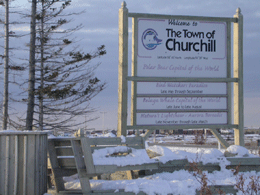
(Photo: Nick Miroff)
CURWOOD: It’s Living on Earth. I’m Steve Curwood. This week we begin a special series called "Early Signs: Reports from a Warming Planet." The series is a collaboration of the UC-Berkeley Graduate School of Journalism, Salon.com, and Living on Earth to document places around the world where people say they’re facing the impact of global warming. Places like the Arctic where it’s warming nearly twice as fast as the rest of the planet, according to a recent, eight-nation study.

As global warming threatens Churchill’s bear population, the town’s pitching bird watching in spring, whale watching in summer, and northern lights viewing in the dead of winter. (Photo: Nick Miroff)
KID: Oh, yeah! Ooooh, man, there’s ice. Woo-hoo! C’mon, let’s go.
[KIDS LAUGHING AND RUNNING]
MIROFF: The first snow came late to Churchill, Manitoba this year.
KID: Trick or Treat!
[KIDS TRICK OR TREATING; TRAFFIC SOUNDS]
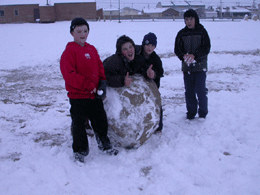
Young Churchillians playing with an ice ball outside Marlborough High School shortly after the season’s first snowfall. (Photo: Nick Miroff)
DYKE: It’s Halloween night and we’re just here handing out treats for the kids and making sure the bears don’t uh…come to town. Hey, guys!
MIROFF: A few hours earlier, a large male polar bear showed up in the town cemetery. So now, the Mounties are out with 12-gauge shotguns to keep the trick-or-treaters safe – from actual monsters.
DYKE: My name is Constable Sean Dyke and I’m with the Churchill Royal Canadian Mounted Police. We have these, uh, bear bangers.
[RATTLING SHELLS]
DYKE: It’s a little explosive charge that gets shot out of the shotgun (rattles) and just gives a huge bang.
[HALLOWEEN SOUNDS]
MIROFF: Churchill is a town of roughly 900 people, a shivering outpost on the otherwise vacant tundra south of the Arctic Circle. There are no roads in. Every fall, about a thousand polar bears lumber around just outside town waiting for Hudson Bay to freeze over. When it does, they’ll cross through Churchill and spend all winter on the ice, gorging on seals.
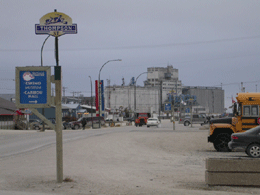
No roads lead to Churchill, Manitoba, a shivering outpost of roughly 900 people just south of the Arctic Circle. Kelsey Blvd. is the only paved street in town. It ends at the Port of Churchill. (Photo: Nick Miroff)
Visitors stay at the Lazy Bear Lodge, they eat at the Hungry Bear Café, and they buy bear mugs, bear key chains, bear sweatshirts, and bear baby bibs. For six weeks, the entire town runs on the rhythms of the tourists. Beat-up school buses take them out to the tundra every morning, and all the restaurants along Churchill’s strip fill up in unison at the end of the day. This routine’s been going on for over a decade. But this year, something’s off.
[HALLOWEEN SOUNDS]
DYKE: The ice is later in forming this year. You take a look at Hudson Bay here and it’s still open water.
MIROFF: So, the bears haven’t moved toward town in their usual numbers yet. Business owners are frustrated because the peak tourist season is almost over. Bear biologists are worried. There’s been a long-term warming trend here, so that freeze-up now comes about two or three weeks later than it used to. Churchillians, like the bears, have been waiting for any sign of winter.
ED: It’s snowing with big snowflakes which I don’t think it’s going to stay on the ground.
MARILYN: No, it’ll be gone by morning. If the wind picks up it’ll be surely gone. You want to grab some more candy, Ed?
[MUSIC]
MIROFF: Churchill has always depended on the bears in one way or another, and it hasn’t always worked out. When Danish explorers first landed here in 1619, they shot and ate them. But the meat was tainted with trichinosis, and nearly all the men died. It took another hundred years for British fur traders to figure out how to survive here, founding a tiny settlement out of a wilderness of belligerent quadrupeds.
[MUSIC ENDS]
PENWARDEN: Everybody in Churchill’s got a bear story. Everybody. (Laughs)
MIROFF: Bob Penwarden and his wife own The Tundra Inn, a small tourist hotel off Churchill’s main drag.
PENWARDEN: That’s a sonar Hageman, a Swedish military machine. It’ll go where you point it.
MIROFF: A slim, decommissioned rocket leans in the lobby behind a fichus, and there are NIKE missile adapters on the porch with plants in them. These are Bob’s keepsakes from the Cold War, a time when Churchill boomed as the U.S. and Canada built up a joint military base outside of town. Bob’s been here since 1962. He got a job launching communications and weather satellites.
PENWARDEN: The town never had a bear problem in those days. The military used lead poisoning; they just shot the bears. I don’t say they went out and hunted them. But if they came around and were a hazard, they took the line of least resistance and done away with them.
MIROFF: Churchill’s population swelled to 6,000 as government agencies and contractors flooded in.
PENWARDEN: Oh yeah, there were parties. They flew in lobster for New Year’s Eve. The military treated us pretty good. We had a real nice theater out there. We had a curling rink. As I say, it was good times. There were a lot of people, and it was a different world.
[HARP MUSIC]
MIROFF: The American military pulled out first. It caused a ripple effect.
PENWARDEN: When the big layoff came, what I refer to as “Black Thursday,” they assembled all of us and told probably a quarter of us that we were staying and the rest were going. So it was a pretty bad day. I had a crew of four people. And I used to say “let’s go gang,” and four of us would go out and work. And after Black Thursday, I had a crew of myself.
MIROFF: By the early eighties, Churchill was down to about 1,000 people. There were rows of empty buildings and an infrastructure the town couldn’t afford to keep up. Rocket shells were littered across the tundra and sunk in the Bay.
[MUSIC ENDS]
DEMEULLES: The soldiers left a lot of little ones behind. Well, it’s the truth. In the long run it was good that they left, because let’s face it, they couldn’t stay here forever. To begin with, I don’t even know what the hell they were doing here! Nobody ever told us anything, so…
MIROFF: Myrtle Demeulles runs a cultural center for people of mixed Inuit and European descent known as the Meti. She’s been in Churchill since 1955, coming at age 14 to find a husband. When the military left, she says, everyone scrambled to pick up the pieces.
DEMEULLES: They had an ambulance service, right? When they left, they gave it to the town. So, because I was already, I had a cab business, I was driving cab anyway, I decided to run the ambulance service, too, for five years. Until someone else took over, thank God.
MIROFF: Mike Spence was a teenager then.
[MUSIC]
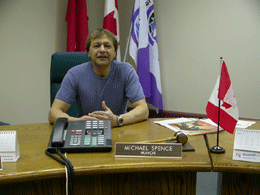
Mayor Mike Spence grew up in Churchill in its military heyday when it was a town of 6,000 people. (Photo: Nick Miroff)
[MUSIC]
SPENCE: There was a local person by the name of Len Smith, who was a mechanic by trade. And he put together just a small buggy. And he went east, east of here. At about that time, there was an American photographer who had had an opportunity to see some bears. Well, they hooked up, and basically, he told Len, he said “Len, you build the buggy and I’ll bring the tourists.”
[MUSIC ENDS]
MIROFF: Mike now runs two hotels, a restaurant, a flooring business, and the town’s only car rental agency. He’s also the mayor. Sitting in the town counsel chambers in a ribbed t-shirt and camouflage hunting jacket, he perks up a little whenever he uses the phrase, “Polar Bear Capital of the World.”
SPENCE: I grew up in a community of 6,000 people. So I’m still inspired to see a population of 6,000 people. That’s what inspires me.
[MOTOR NOISE, CAMERA SHUTTERS]
TOUR GUIDE: Sometimes it’s just about taking a quick shot, putting the camera down and enjoying the moment. Beautiful, beautiful. Be able to see a bear walk on the ice along there. Beautiful.
[TOURISTS CHATTERING, LAUGHING EXCITEDLY]
[MUSIC]
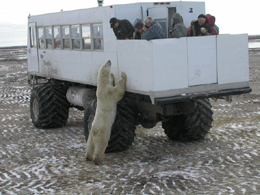
Tundra Buggies cart tourists over the tundra to overse the bears as they bide their time waiting to get back on the ice. Sometimes the bears observe them, too. (Photo: Nick Miroff)
TOURIST: One picked a pile of mud to lay down on. One is on straw.
[CAMERA SHUTTERS, CHATTER]
MIROFF: The rocket range in the distance, where Bob Penwarden once worked, is now a research center. A non-profit called Polar Bears International has been bringing scientists from all over North America to educate school and tour groups. Questions about global warming inevitably come up.
[SOUND OF CONVERSATION]
MIROFF: Dr. Jane Waterman is spending the afternoon on a tundra buggy monitoring bear behavior with a group of volunteers.
WATERMAN: The bears’ males will move onto land when the ice melts in July and, basically, go splat. Remember, these guys are on holiday right now. There’s no food, there’s no sex, there’s nothing. And it’s when the sea ice forms that they can get back out there and make a living.
[MUSIC]
MIROFF: A living for a male polar bear goes like this: stalking across the frozen Bay for six months, ambushing seal pups and yanking them through the ice. All they eat is the fat. A large male bear can eat 150 pounds of it on a good day.
[VOLUNTEER CHATTER]
MIROFF: The bears stay on the ice until the last of it melts on the part of Hudson Bay south of Churchill. There, they decamp. They spend all summer living off reserves in what’s called “waking hibernation,” waiting for freeze up. But, in fall, when the ice begins to form again, it forms first on the opposite side of Churchill—so the town is in their way.
[MOTOR NOISE]
WATERMAN: Most of them go through town because it’s their major migration zone, and they’ve been doing that for thousands of years, way before the town was there. Within 24 hours of the sea ice actually forming, these bears are gone.
MIROFF: Warmer temperatures mean the Bay is frozen for a shorter stretch each year--lengthening the time when the bears are forced onto land and not eating. As the ice disappears, researchers in Alaska report polar bears drowning, forced to swim between increasingly distant ice floes. Also, with less time on the ice to hunt, more bears are seen scavenging the beaches for whale carcasses.
WATERMAN: Certainly this is one of the warmest years I’ve ever seen. Usually in November we’re starting to see freeze up, and these fresh water ponds are still open water in them. And I don’t know if I’ve ever seen it like that at this time.
MIROFF: Churchill’s bear population has already fallen more than 20 percent in the past 17 years, and U.S. and Canadian researchers found this directly correlates to the loss of sea ice. The short-term predictions are dire.
GUNTER: My name’s Merv Gunter. My wife Linda and I own and operate the Tundra Buggy Adventure, the polar bear experience up in Churchill, Manitoba, and it’s probably the most fun job of anybody in the whole world.
MIROFF: Merv used to be a banker in Winnipeg. He may have more invested in Churchill’s bears than anyone.
GUNTER: Are we worried? Yes, I’m afraid so. And I think we should do everything we can about it. And can we do anything more than that to stop climate change? No. So we will co-exist with that. We’ll have to. As will the bears. They’re a very tenacious and a very amazing species with their ability to evolve and to adapt.
MIROFF: Some folks in Churchill seem convinced that the bears will find a way to survive. That they’ll learn to eat berries and evolve into grizzlies. The town has always gotten by on its pioneering spirit, especially after the military left. It may be they expect the same stubborn resilience out of their bears. But for the bears, it isn’t a question of will.
WATERMAN: Natural selection can happen very quickly in, like, bacteria, because they can breed in 20 minutes. Polar bears live 20 or 25 years. That means that for changes to occur genetically, it’s going to take a little bit of time. And that’s something they don’t have. So, no, if the change is as rapid as all the climate models predict, by the middle of this century, there’s no sea ice in Hudson Bay, there are no bears. If there’s no sea ice, you can’t have bears.
MIROFF: The irony of all of this is that, as the ice vanishes, taking the bears with it, global warming is clearing the way, literally, for a whole other industry.
[MUSIC]
MIROFF: Churchill happens to have Canada’s only Arctic seaport. It’s a summer port where ships load up on grain from the Canadian prairies. But that season is extending now, too. And with less ice, new trade routes are opening up through the Arctic to Russia.
But really, few people in town see this as a savior. Drumming up business for the port is up to the American company that owns it, and the Canadian Wheat Board down south. Instead, in Churchill, a frontier town where people are used to doing for themselves, there’s a curious streak of wishful entrepreneurialism about almost everything else.
Bob Penwarden bought the dilapidated radar station where he used to work and has talked about turning it into a convention center. One town planner wants to set up a call center in Churchill, or to manufacture pre-fab housing, even if it means having to haul it over the ice to Inuit communities further North. And even though Churchill’s difficult and expensive to get to, the town’s pitching bird watching in spring, whale watching in summer, and Northern Lights viewing in the dead of winter--when it’s 40 below.
SPENCE: We’re trying to build momentum with what we have, and naturally what we have, and again, I’ll refer to it as the “Polar Bear Capital of the World.” That is a selling point and that’s what we need to use. We need to build on it, we need to capitalize on it, and if we don’t, then we’re gonna slide and we can’t afford to slide.
DEMEULLES: We love this place. We learn to live with what’s happening—except for this warm weather! We just don’t understand what the heck’s going on. And really believe it’s the big cities down south causing it.
SPENCE: You know, the earth is warming, and so there are some dangers in climate change, as well. The bears, for instance, and how will they survive in a community that’s the Polar Bear Capital of the World.
DEMEULLES: I want to see what happens, if I have that many years left. I’ve got a mouth. And I’m a motor mouth. And if need be, I’ll speak up for the bears.
PENWARDEN: I’m worried. Because it’s the livelihood of a lot of people in this town. But I, I, I believe home is here for those bears. I don’t say these scientists are right. But I don’t even believe they’re right on this global warming. The bears, this is home. I, I, you know, I may be dead wrong. And, and, they do wander, and hell knows where they go? But they’ll be back, next spring.
[MUSIC]
CURWOOD: Our story about the polar bears of Churchill, Manitoba, was produced by Jon Mooallem and Nick Miroff. Next week, we travel to East Africa, to Lake Tanganyika. Water temperature in the world’s second deepest lake is rising, and some fear that could upset the balance of the nation's staple food, the sardine known as dagaa.
MAN: Oh it was so good. When we used to fish with our fathers, it was very good. There were so many dagaa. People could fish 5,000 tons. In tons! Back in those days there was so much dagaa.
CURWOOD: “Early Signs” is a collaboration of the UC-Berkeley Graduate School of Journalism, Salon dot com, and Living on Earth. To read a print version of this story and see photos of the polar bears of Churchill, visit our website Living on Earth dot org. That’s Living on Earth dot org.
 |
 |  |  |
Related link:
To see a print version of this story & more photos of the polar bears of Churchill, click here
[MUSIC: Dean Evenson & Lorellei “Terra” from ‘Artic Refuge: A Gathering Of Tribes’ (Soundings of the Planet – 1996)]
CURWOOD: We leave you this week with a harbinger of spring – at least here in the Northern States.
[BIRD CALLS]
CURWOOD: Yup, they’re out there pulling at them worms. This is the call of the American Robin, courtesy of the Ornithology Lab at Cornell University.
[EARTH EAR: “American Robin” recorded by Richard K Walton & Robert W. Lawson from “Birding by Ear: Eastern/Central” (Laboratory of Ornithology of Bioacoustics – 1989)]
CURWOOD: Living on Earth is produced by the World Media Foundation. Our crew includes Ashley Ahearn, Chris Ballman, Eileen Bolinsky, Rachel Gotbaum and Ingrid Lobet - with help from Christopher Bolick, Kelley Cronin, James Curwood and Michelle Kweder. Our interns are Bobby Bascomb, Paige Doughty and Emily Taylor. Our technical director is Dennis Foley. Alison Dean composed our themes. You can find us at LOE dot org. I’m Steve Curwood. Thanks for listening.
ANNOUNCER: Funding for Living on Earth comes from the National Science Foundation, supporting coverage of emerging science; and Stonyfield Farm. Organic yogurt and smoothies. Stonyfield pays its farmers not to use artificial growth hormones on their cows. Details at Stonyfield dot com. Support also comes from NPR member stations, the Ford Foundation, the Geraldine R. Dodge Foundation, and the Saunders Hotel Group of Boston's Lennox and Copley Square Hotels. Serving you and the environment while helping preserve the past and protect the future, 800-225-7676.
ANNOUNCER2: This is NPR, National Public Radio.
Living on Earth wants to hear from you!
Living on Earth
62 Calef Highway, Suite 212
Lee, NH 03861
Telephone: 617-287-4121
E-mail: comments@loe.org
Newsletter [Click here]
Donate to Living on Earth!
Living on Earth is an independent media program and relies entirely on contributions from listeners and institutions supporting public service. Please donate now to preserve an independent environmental voice.
NewsletterLiving on Earth offers a weekly delivery of the show's rundown to your mailbox. Sign up for our newsletter today!
 Sailors For The Sea: Be the change you want to sea.
Sailors For The Sea: Be the change you want to sea.
 The Grantham Foundation for the Protection of the Environment: Committed to protecting and improving the health of the global environment.
The Grantham Foundation for the Protection of the Environment: Committed to protecting and improving the health of the global environment.
 Contribute to Living on Earth and receive, as our gift to you, an archival print of one of Mark Seth Lender's extraordinary wildlife photographs. Follow the link to see Mark's current collection of photographs.
Contribute to Living on Earth and receive, as our gift to you, an archival print of one of Mark Seth Lender's extraordinary wildlife photographs. Follow the link to see Mark's current collection of photographs.
 Buy a signed copy of Mark Seth Lender's book Smeagull the Seagull & support Living on Earth
Buy a signed copy of Mark Seth Lender's book Smeagull the Seagull & support Living on Earth

